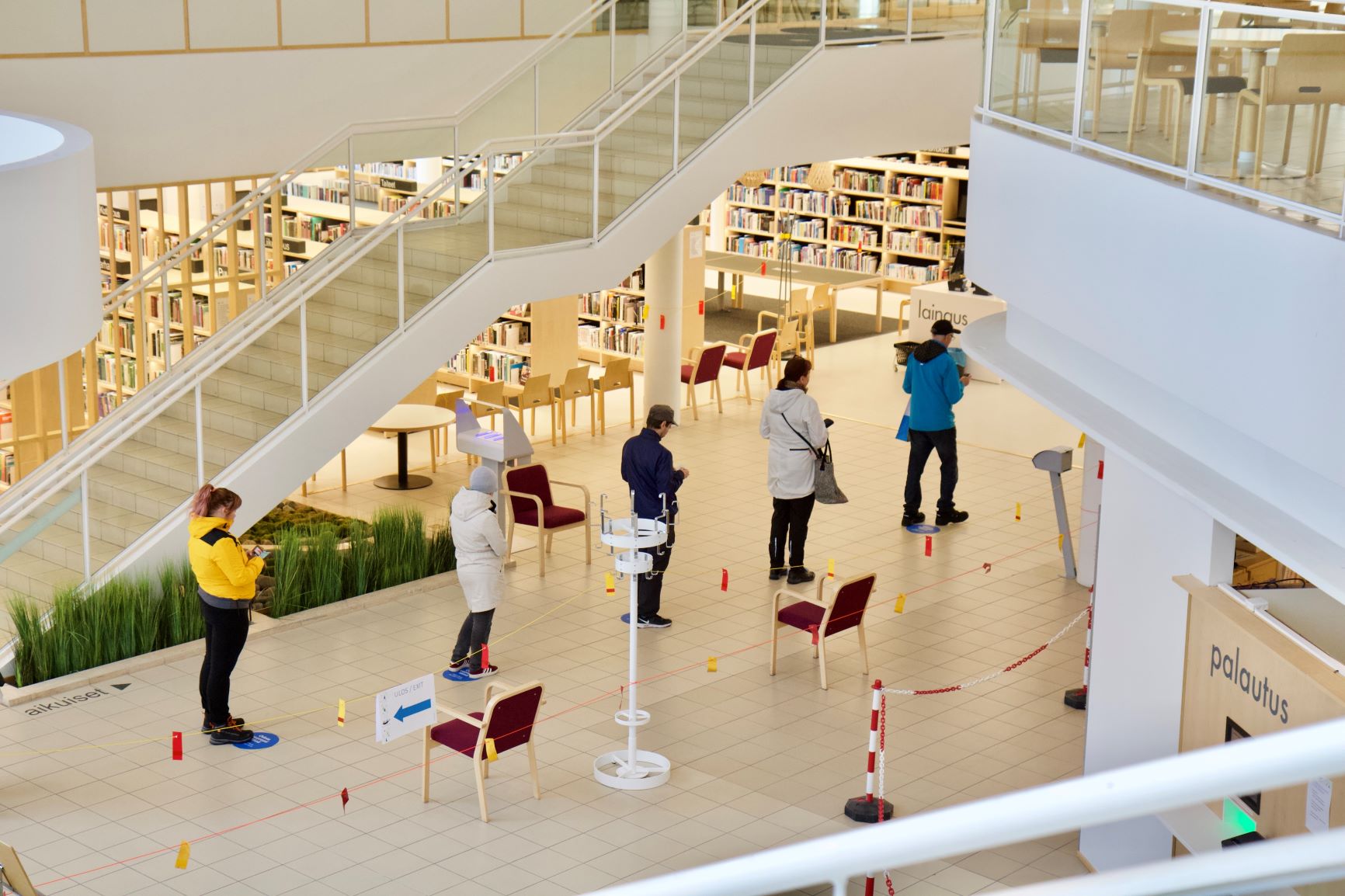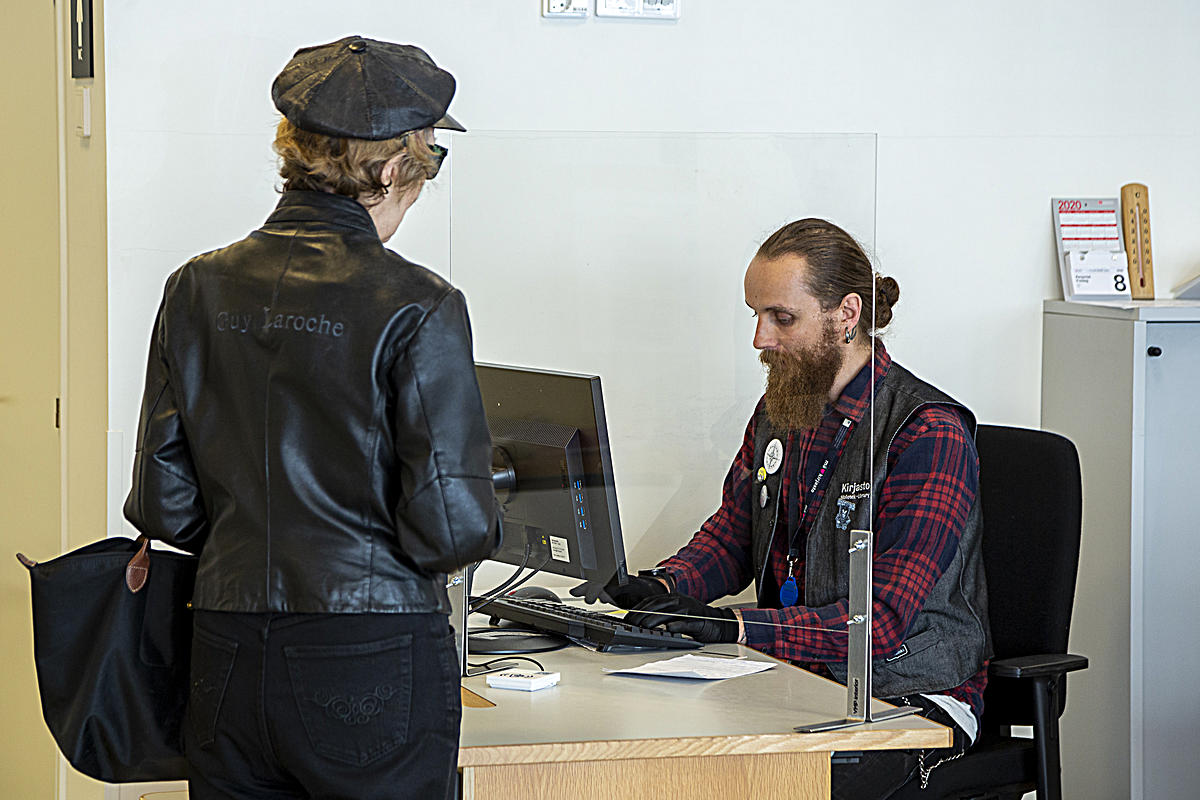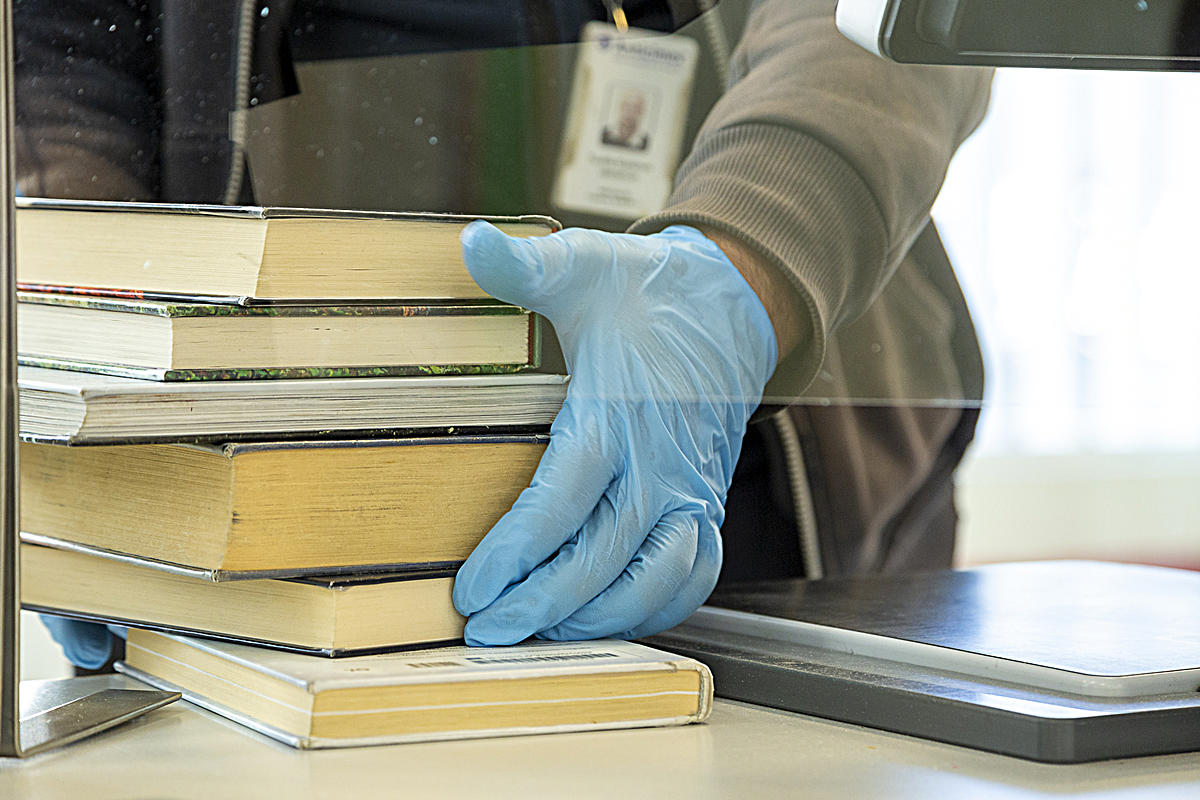
In Finland, libraries closed their doors temporarily on 18 March 2020 due to the Covid-19 pandemic. The closure of library premises was initially expected to last at least until mid-May, however, on 4 May the government allowed all public libraries to restart their lending services immediately. The decision allowed libraries to offer limited services whilst the library premises remain largely closed until 1 June. In this article, we offer an overview of Finnish public libraries’ Covid-19 response and the first experiences of restarting physical services.
What follows is a rough timeline and selected measures taken by Finnish public libraries.
Initial response: innovating new services
As part of declaring the state of emergency in Finland, the Finnish government announced the closure of many public services and other restrictions on 16 March 2020. Libraries, museums, theatres, and other national and municipal public institutions had to close their physical premises from 18 March onward. Soon after, the initial closure period was extended by a new government decision from mid-April to 13 May; it was clear that the physical premises would stay closed for a long while. Libraries needed to find new ways to make high-quality library services available, as well as ways to promote existing eServices during the lockdown period.
Very quickly, libraries started to produce online content via livestreams and videos. For example, Turku City Library started daily morning coffee sessions on Instagram Live from the very first closure day. The first few Instagram Live sessions were focused on practicalities of library services during the closure, but the staff also gave reading tips to library users, amongst other things. As the days passed, the themes of the morning live sessions varied from literature to board games, and from health issues to feelings during the lockdown.
Helsinki City Library started streaming regular literature programmes with guest authors as of 20 March. The response was swift, as the first book talk with an author was streamed on the third day of closure. Soon, Helsinki City Library’s livestream programmes expanded from literature to cover other fields of arts as well as different aspects of library services.
Turku’s Instagram Live also helped to fill the social gap left by the closure of physical services, as the regular sessions offered a channel for interaction. Many traditional library services easily found their way to online environments. Some libraries, for example the Keski-Kirjastot library network in Central Finland, held reading clubs online and thus both contributed to libraries’ literature work and offered a place for social interaction.
At the beginning of the lockdown, some smaller libraries offered limited book lending services, by taking phone orders and placing the pre-packed bags outside the library for collection. Some libraries experimented with handing out pre-packed bags of books that had been removed from library collections, with the bags hung up outside for anyone to collect. In addition to this, in the first weeks of the closure periods, a few libraries offered an option to return checked out books. However, before long the Regional State Administrative Agencies (RSAA) clarified the guidelines: all handling of physical materials was banned for public libraries.
Challenges with copyrights and licenses
Libraries keenly jumped into the world of content production. Some libraries had more experience in producing online content, whilst others took a giant leap into digital content production and services. When thinking about what kind of video content a library should produce, the immediate reaction by many librarians was storytelling sessions. This naturally led to copyright questions. Since there was no national copyright agreement allowing libraries to do online storytelling sessions and book readings, many libraries approached authors directly each time, or invited authors to do readings themselves. Most libraries also resorted to older literature that was already in the public domain.
An agreement between the Finnish Consortium of Public Libraries and the publishers’ association was reached on 22 April. This allowed all public libraries to produce videos containing copyrighted literature and images for periods of two months, however, the publishing channels were limited to two, of which only one allows for sharing or embedding the video content. All videos are now published via Library Channel, which is a national public service producing videos and live streaming for libraries, and Helsinki Channel, which is a video service produced by the City of Helsinki. There has been a notable increase in the use of Library Channel during the lockdown. Compared with statistics from 1 January – 11 May last year, there is an overall increase of 60% in site sessions. Library Channel also provides video content for librarians’ professional development, so part of the traffic on the website comes from within the library field.
eResources have been heavily promoted since the beginning of the lockdown. The use of eBooks and other eResources peaked at a record high in most libraries. Finland does not have a shared national eLibrary collection, so libraries that had the resources to acquire more licences started to buy more as demand went up. This, of course, happened retroactively, since no one had prepared for such a sudden and steep increase in demand for eBooks, eMagazines and eNewspapers. For example, in the two library networks around the cities of Tampere and Jyväskylä, the use of eBooks went up by 76% and 101% respectively. Shared national eServices also saw a significant increase in their use. For example, Ask a librarian service had an increase in site sessions of approximately 50% compared with last year’s figures.
As the use of eResources went up, libraries faced yet another problem: how could they issue a new library card if someone needed to prove their identity in person at the library? Libraries did not have processes in place to create new member accounts online if people wanted to join the library during the lockdown. This was quickly resolved by creating temporary library cards that people could apply for online and use only during the lockdown period to access the eCollections from home.
Preparing to reopen restricted services

The very first step toward partly restarting library services was taken on 23 April, when libraries were allowed to reopen their book return boxes, which could be operated even though libraries remained closed. The situation after 4 May was that public libraries could start their lending services, whilst the library premises would remain closed until 1 of June. This was soon clarified to mean that library premises could be opened only to facilitate the lending service and the library premises should not be used for anything else. Roughly speaking, two approaches have emerged: One approach is to establish a pickup and return point where library users can quickly pop in and out to pick up pre-reserved books and return their checked-out books. The other approach is to open the collection areas but close all other areas, such as reading rooms, meeting rooms, studios, makerspaces, etc. so that people can quickly pick up books and other materials from the shelves themselves.
The first public libraries opened their doors with restricted services as early as Friday 8 May, a few more followed on Monday 11 May, and more will open as soon as their resources permit.
Many libraries were making preparations to open on 14 May, which was the initial end date of the restrictions, but some libraries were not very far into their preparations for opening as it was by no means clear that libraries would be able to open in mid-May. Moreover, many libraries had their staff temporarily laid off or moved to other operations, so staff resources are now one of the main issues in many municipalities when reopening the libraries. Additionally, staff availability had a key effect on choosing how to open the library, as a single pick-up point requires fewer staff than opening the collection areas, for example.
Choosing the open approach

Helsinki City Library was one of the first public libraries to open some of its branches as early as Friday 8 May, and it chose the more open approach. Helsinki opened 11 of its 37 branch libraries on 8 May and more will open gradually from 11 May onward. In Helsinki, the open approach to restricted services means that people can access the shelves themselves, while other services and uses of the premises are restricted.
For example, all seating and tables may have been removed from library premises, and all areas except for collection areas are locked or fenced off so people do not stay and spend excess time in the library. Newspaper and magazine reading areas are also closed, and customer computers have been removed. Staff handling the physical collection are wearing gloves and have been instructed on effective hand hygiene. The service desks are shielded with plexiglass and no cash is accepted as a form of payment. Library users have been instructed and reminded by signs and floor stickers to swiftly carry out their library errands, as well as to keep their distance from other people while visiting the library. Additionally, bigger libraries will only keep a minimum amount of service desks open and library users are encouraged to use the self-checkout and return machines. The number of people in the premises is being constantly monitored and if there are too many library users inside the premises at one time, doors will be temporarily closed.
A similar approach has been adopted in other municipal libraries, ranging from big libraries to smaller municipal library networks.
Ending up with a more restricted approach
Most public libraries in Finland chose a more restricted approach for the first phase of opening library services. For example, in the City of Tampere in central Finland, the city library reopened the lending services of five branch libraries on Monday 11 May after opening book return boxes on Monday 4 May. Tampere’s model of opening in the first phase is to establish pickup points in the partly reopened branches. In Tampere’s main library, Metso, librarians have built a one-way route to the pickup point, guiding people to enter one way and exit the other way. The other parts of the building have been fenced off, so access is only permitted to the pickup point and way out. The same cautious measures when handling physical collection items as well as instructions for hand hygiene and keeping a safe distance from others are in place as in all opened libraries.

Regulating the opening: guidelines
The decision to close all library premises was a part of the government decree declaring a state of emergency in Finland. Government decisions are implemented by the Regional State Administrative Agencies (RSAA), who also provide guidelines regulating libraries’ operations during the lockdown. When libraries started to open up, the guidelines were based on general workplace health and safety regulations for customer service work during the Covid-19 pandemic, thus they were largely not specific to library work.
The first step of restarting the services was allowing libraries to reopen their book return boxes so that people could return their checked-out books from 23 April onward. Libraries feared that when the doors were finally fully opened again, people would rush in to return their books, even though due dates had been pushed forward generously. Allowing libraries to receive checked-out items took some pressure off them in terms of preparing for the possible rush caused by the reopening. The RSAA’s guidelines for handling returned items emphasised the importance of good hand hygiene when handling the collection, but quarantining or disinfecting books was not required. However, many libraries are voluntarily keeping returned items in quarantine.
The second phase of opening has been allowed from 4 May onward, and the first libraries opened on Friday 8 May. Precautionary measures as described above were taken in many places. The official guidelines stated that libraries could open their lending services, as long as they could comply with health officials’ instructions on workplace health and safety. There is still a general national restriction of public gatherings to 10 people, but this does not apply to libraries’ lending services. The restriction of public gatherings will be lifted up to 50 people on 1 June – at the same time as library premises are more widely opened – but the public gathering restrictions will only apply to public events held in libraries, not the actual library premises when used for basic library services. More guidelines are expected to be released by the beginning of June.
After opening restricted lending services, libraries are still not able to offer an access to customer computers in their premises. This is highly problematic with regard to equality. As public and private services are moving online at accelerating pace, libraries’ customer computers have been for many the only point of access to these services. Access to Internet has become a necessity in order to fully function in contemporary societies. To tackle the problem, municipalities are finding ways to provide access to internet in other premises than libraries. For example, the City of Helsinki is opening a temporary digital self-service point in a municipality building, for residents who do not have their own computer or smartphone. In Helsinki, library staff is providing assistance at the temporary service point. In these set-ups all necessary safety measures, such as disinfecting of hands, devices, and safety distances, have been considered.
The experiences from the first week of gradual restricted opening of libraries’ lending services show that, even though the feedback from library users has been overwhelmingly delighted and excited, libraries have not experienced a rush of booklovers crowding the partly-opened libraries. The first week and days have been relatively calm in libraries, since people are still largely avoiding moving around except for absolute necessities. It is also worth noting that not all libraries have opened yet, and it is up to each municipality to decide the pace and extent of opening libraries within the framework given by the RSAAs and national health authorities.
